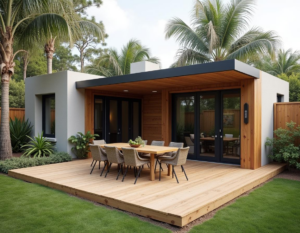Accessory Dwelling Units (ADUs) have become a popular way to add living space, accommodate family members, or generate rental income. However, financing an ADU can be challenging due to their unique nature. Here are five ways to finance the construction or purchase of an ADU, helping homeowners and investors make informed decisions.
1. Home Equity Loans and Lines of Credit
Home equity loans and lines of credit are common methods for financing ADUs. These options allow homeowners to borrow against the equity in their primary residence. A home equity loan provides a lump sum at a fixed interest rate, making it a good option for financing an ADU project with a defined budget. Alternatively, a home equity line of credit (HELOC) offers flexible borrowing with variable interest rates, suitable for projects with fluctuating costs.
2. Cash-Out Refinance
A cash-out refinance involves refinancing your existing mortgage for more than you owe and taking the difference in cash. This can be a smart way to finance an ADU if you can secure a lower interest rate than your current mortgage. It consolidates your debt into one monthly payment and provides a lump sum to cover construction costs.
3. Construction Loans
Construction loans are short-term loans used to finance the building of a new structure, including ADUs. These loans typically cover only the period of construction and are converted into a traditional mortgage upon completion of the project. They’re ideal for funding ADU projects from the ground up, but they come with higher interest rates and stringent qualification criteria.
4. Government Loans and Grants
Some local and federal government programs offer loans and grants for ADU construction, especially if the unit is intended for affordable housing or to accommodate family members with specific needs. For example, the U.S. Department of Housing and Urban Development (HUD) offers programs that can be used to finance ADUs in some circumstances. Researching local programs and incentives is crucial, as availability and eligibility can vary widely.
5. Personal Loans and Savings
For those without sufficient home equity or who prefer not to use their home as collateral, personal loans can be a viable option. Personal loans are unsecured, meaning they typically have higher interest rates than home equity products but offer quicker funding without the need for property appraisals. Additionally, using personal savings to finance an ADU project can eliminate interest costs, though it requires a significant amount of liquid assets.
Conclusion
Financing an ADU requires careful consideration of the costs, your financial situation, and the available financing options. Whether you opt for a loan against your home equity, a government program, or personal savings, it’s important to compare rates, terms, and eligibility requirements. Consulting with a financial advisor or mortgage broker can provide personalized advice and help navigate the complexities of ADU financing. By choosing the right financing method, you can make your ADU project a reality and add significant value to your property.






